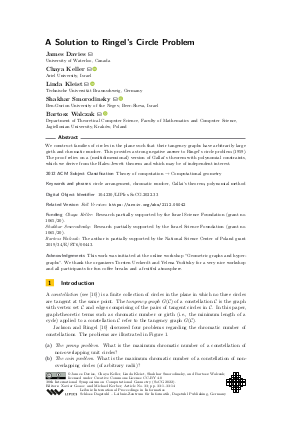A Solution to Ringel’s Circle Problem
Authors
James Davies,
Chaya Keller  ,
Linda Kleist
,
Linda Kleist  ,
Shakhar Smorodinsky
,
Shakhar Smorodinsky  ,
Bartosz Walczak
,
Bartosz Walczak 
-
Part of:
Volume:
38th International Symposium on Computational Geometry (SoCG 2022)
Part of: Series: Leibniz International Proceedings in Informatics (LIPIcs)
Part of: Conference: Symposium on Computational Geometry (SoCG) - License:
 Creative Commons Attribution 4.0 International license
Creative Commons Attribution 4.0 International license
- Publication Date: 2022-06-01
File

PDF
LIPIcs.SoCG.2022.33.pdf
- Filesize: 0.92 MB
- 14 pages
Document Identifiers
Related Versions
- Full Version https://arxiv.org/abs/2112.05042
Subject Classification
ACM Subject Classification
- Theory of computation → Computational geometry
Keywords
- circle arrangement
- chromatic number
- Gallai’s theorem
- polynomial method
Metrics
- Access Statistics
-
Total Accesses (updated on a weekly basis)
0PDF Downloads0Metadata Views
Abstract
We construct families of circles in the plane such that their tangency graphs have arbitrarily large girth and chromatic number. This provides a strong negative answer to Ringel’s circle problem (1959). The proof relies on a (multidimensional) version of Gallai’s theorem with polynomial constraints, which we derive from the Hales-Jewett theorem and which may be of independent interest.
Cite As Get BibTex
James Davies, Chaya Keller, Linda Kleist, Shakhar Smorodinsky, and Bartosz Walczak. A Solution to Ringel’s Circle Problem. In 38th International Symposium on Computational Geometry (SoCG 2022). Leibniz International Proceedings in Informatics (LIPIcs), Volume 224, pp. 33:1-33:14, Schloss Dagstuhl – Leibniz-Zentrum für Informatik (2022)
https://doi.org/10.4230/LIPIcs.SoCG.2022.33
BibTex
@InProceedings{davies_et_al:LIPIcs.SoCG.2022.33,
author = {Davies, James and Keller, Chaya and Kleist, Linda and Smorodinsky, Shakhar and Walczak, Bartosz},
title = {{A Solution to Ringel’s Circle Problem}},
booktitle = {38th International Symposium on Computational Geometry (SoCG 2022)},
pages = {33:1--33:14},
series = {Leibniz International Proceedings in Informatics (LIPIcs)},
ISBN = {978-3-95977-227-3},
ISSN = {1868-8969},
year = {2022},
volume = {224},
editor = {Goaoc, Xavier and Kerber, Michael},
publisher = {Schloss Dagstuhl -- Leibniz-Zentrum f{\"u}r Informatik},
address = {Dagstuhl, Germany},
URL = {https://drops.dagstuhl.de/entities/document/10.4230/LIPIcs.SoCG.2022.33},
URN = {urn:nbn:de:0030-drops-160413},
doi = {10.4230/LIPIcs.SoCG.2022.33},
annote = {Keywords: circle arrangement, chromatic number, Gallai’s theorem, polynomial method}
}
Author Details
Funding
- Keller, Chaya: Research partially supported by the Israel Science Foundation (grant no. 1065/20).
- Smorodinsky, Shakhar: Research partially supported by the Israel Science Foundation (grant no. 1065/20).
- Walczak, Bartosz: The author is partially supported by the National Science Center of Poland grant 2019/34/E/ST6/00443.
Acknowledgements
This work was initiated at the online workshop "Geometric graphs and hypergraphs". We thank the organizers Torsten Ueckerdt and Yelena Yuditsky for a very nice workshop and all participants for fun coffee breaks and a fruitful atmosphere.
References
-
Kenneth Appel and Wolfgang Haken. Every planar map is four colorable. Part I: Discharging. Illinois Journal of Mathematics, 21(3):429-490, 1977.

-
Kenneth Appel, Wolfgang Haken, and John Koch. Every planar map is four colorable. Part II: Reducibility. Illinois Journal of Mathematics, 21(3):491-567, 1977.

-
Harold Scott Macdonald Coxeter. Introduction to geometry. John Wiley & Sons, 1961.

- James Davies. Box and segment intersection graphs with large girth and chromatic number. Advances in Combinatorics, 2021:7, 9 pp., 2021. URL: https://doi.org/10.19086/aic.25431.
-
Aubrey D. N. J. de Grey. The chromatic number of the plane is at least 5. Geombinatorics, 28:5-18, 2018.

-
Blanche Descartes. A three colour problem. Eureka, 9(21):24-25, 1947.

-
Blanche Descartes. Solution to advanced problem no. 4526. The American Mathematical Monthly, 61:352, 1954.

- Hillel Furstenberg and Yitzhak Katznelson. A density version of the Hales-Jewett theorem. Journal d’Analyse Mathématique, 57:64-119, 1991. URL: https://doi.org/10.1007/BF03041066.
-
Andrew W. Hales and Robert I. Jewett. Regularity and positional games. Transactions of the American Mathematical Society, 106(2):222-229, 1963.

- Brad Jackson and Gerhard Ringel. Colorings of circles. The American Mathematical Monthly, 91(1):42-49, 1984. URL: https://doi.org/10.1080/00029890.1984.11971333.
-
Tommy R. Jensen and Bjarne Toft. Graph Coloring Problems. John Wiley & Sons, 1995.

-
Gil Kalai. Some old and new problems in combinatorial geometry I: Around Borsuk’s problem. In Artur Czumaj, Agelos Georgakopoulos, Daniel Kráľ, Vadim Lozin, and Oleg Pikhurko, editors, Surveys in Combinatorics, volume 424 of London Mathematical Society Lecture Note Series, pages 147-174. Cambridge University Press, 2015.

-
Paul Koebe. Kontaktprobleme der konformen Abbildung. Berichte über die Verhandlungen der Sächsischen Akademie der Wissenschaften zu Leipzig, Mathematisch-Physische Klasse, 88:141-164, 1936.

- Alexandr V. Kostochka and Jaroslav Nešetřil. Properties of Descartes' construction of triangle-free graphs with high chromatic number. Combinatorics, Probability and Computing, 8(5):467-472, 1999. URL: https://doi.org/10.1017/S0963548399004022.
-
János Pach. Finite point configurations. In Jacob E. Goodman, Joseph O'Rourke, and Csaba D. Tóth, editors, Handbook of Discrete and Computational Geometry, pages 26-50. CRC Press, 3rd edition, 2017.

- Hans Jürgen Prömel and Bernd Voigt. A sparse Graham-Rothschild theorem. Transactions of the American Mathematical Society, 309(1):113-137, 1988. URL: https://doi.org/10.1090/S0002-9947-1988-0957064-5.
- Hans Jürgen Prömel and Bernd Voigt. A sparse Gallai-Witt theorem. In Rainer Bodendiek and Rudolf Henn, editors, Topics in Combinatorics and Graph Theory, pages 747-755. Physica-Verlag Heidelberg, 1990. URL: https://doi.org/10.1007/978-3-642-46908-4_84.
-
Richard Rado. Note on combinatorial analysis. Proceedings of the London Mathematical Society, 48:122-160, 1945.

-
Gerhard Ringel. Färbungsprobleme auf Flächen und Graphen, volume 2 of Mathematische Monographien. VEB Deutscher Verlag der Wissenschaften, 1959.

-
Alexander Soifer. The Mathematical Coloring Book: Mathematics of Coloring and the Colorful Life of its Creators. Springer, 2009.

-
Bartel L. van der Waerden. Beweis einer Baudetschen Vermutung. Nieuw Archief voor Wiskunde, 15:212-216, 1927.

